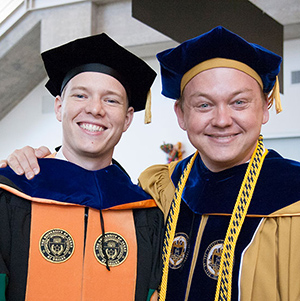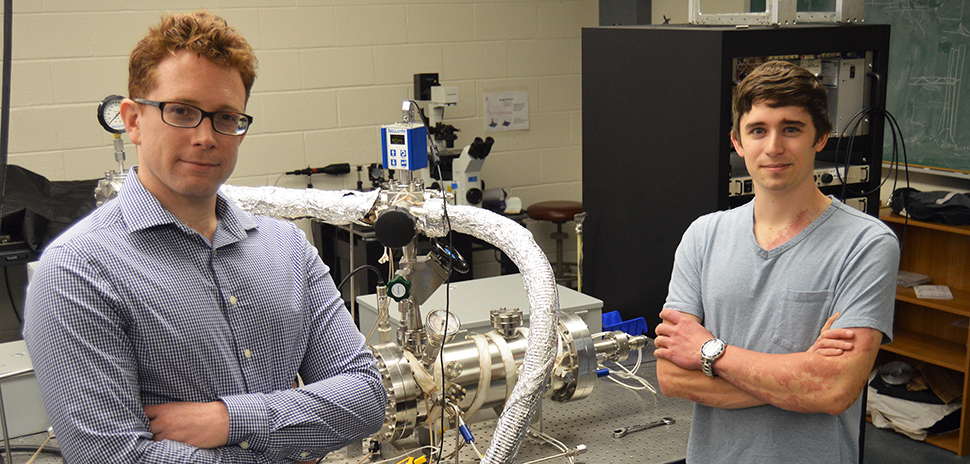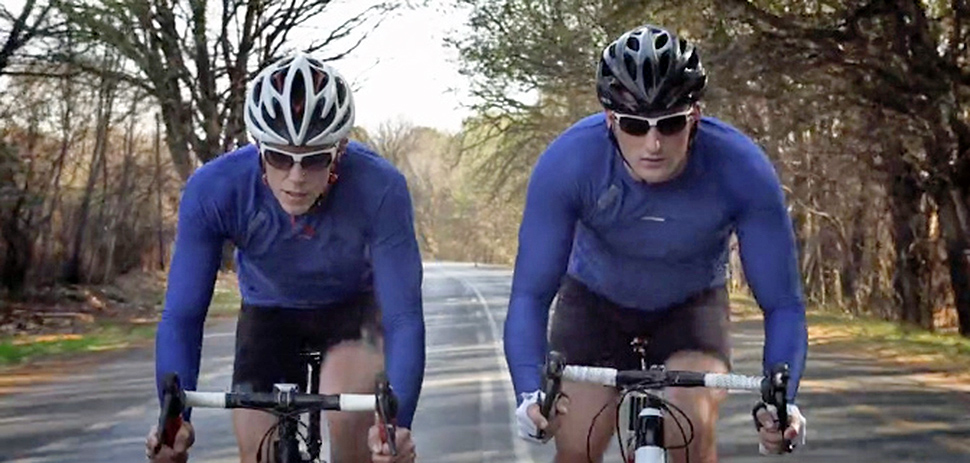E-WHISKERS MIMIC THE REAL THINGS AS TOUCH SENSORS
![]() Have you ever been intrigued by the whiskers on your pet cat or dog? Maybe not, but researchers at the University of Texas at Dallas are, and they’ve created artificial, electronic versions called e-whiskers.
Have you ever been intrigued by the whiskers on your pet cat or dog? Maybe not, but researchers at the University of Texas at Dallas are, and they’ve created artificial, electronic versions called e-whiskers.

Jonathan Reeder (left) with Walter Voit [Photo courtesy of UT Dallas]
After all, whiskers aren’t just cute. They’re actually touch receptors that send important information to the animal’s brain that helps it make sense of its environment.
The hair-like e-whiskers are made using shape-memory polymers that mimic the real things, and are a major advancement toward engineering electronic human skin, the researchers said. The scientists described their work in a paper published recently in the journal Advanced Materials.
“There are some really interesting examples in the animal kingdom of how whiskers are useful for probing and interrogating the environment,” lead author Jonathan Reeder said.
He conducted the research as a doctoral student in the Erik Jonsson School of Engineering and Computer Science. Reeder worked on the research with his doctoral mentor, Walter Voit, an associate professor of materials science and engineering and mechanical engineering, also an author of the paper.

UTA assistant professor of physics Benjamin Jones (left) with physics doctoral student Austin McDonald, who is working on this project. [Photo courtesy of UT Arlington]
$750K DOE GRANT TO FUND RESEARCH INTO SUBATOMIC PARTICLE
An assistant professor of physics at the University of Texas at Arlington has gotten a major grant to study the tiniest of particles.
The U.S. Department of Energy awarded Benjamin Jones $750,000 to develop a sensor for particle experiments focusing on the neutrino, a subatomic particle that UTA said might offer an answer to the long-standing mystery of the universe’s matter-antimatter imbalance.
“My research focuses on the search for neutrinoless double beta decay — a hypothetical nuclear process, which, if discovered, would prove that neutrino particles are their own anti-particles, and illuminate the origin of their extremely small mass,” Jones said in the release. “It is a great honor to receive this award to further this research over the next five years.”
He was one of 84 young scientists from leading national research institutions who received the award in 2018, according to UTA.
Find out more about his research here.

[Screenshot courtesy of UT Southwestern video]
STUDY EXAMINES EXERCISE, DEPRESSION AND MAINTAINING GOOD HEALTH
A collaborative study between UT Southwestern Medical Center and The Cooper Institute has found that exercise may be important to the health of a person with depression — just as critical as finding an antidepressant that works.
After studying almost 18,000 participants, researchers discovered that those with a high level of fitness at middle age were far less likely to die from heart disease in later life, even if they had been diagnosed with depression, according to UT Southwestern.
“Maintaining a healthy dose of exercise is difficult, but it can be done. It just requires more effort and addressing unique barriers to regular exercise.”
Dr. Madhukar Trivedi
The recently published research reinforces the many ways that depression can impact health and mortality, and It highlights the importance of overcoming a common dilemma among patients — How does a person cope with hopelessness, but still find the motivation to exercise regularly?
“Maintaining a healthy dose of exercise is difficult, but it can be done. It just requires more effort and addressing unique barriers to regular exercise,” Dr. Madhukar Trivedi, co-author of the study and director of the Center for Depression Research and Clinical Care at UT Southwestern, said in a release.
The study used a Cooper Institute database of participants who had their cardiorespiratory fitness measured at an average age of 50 years. The researchers then used Medicare administrative data to find correlations between the subjects’ fitness at midlife to rates of depression and heart disease in older age.
READ NEXT
![]()































